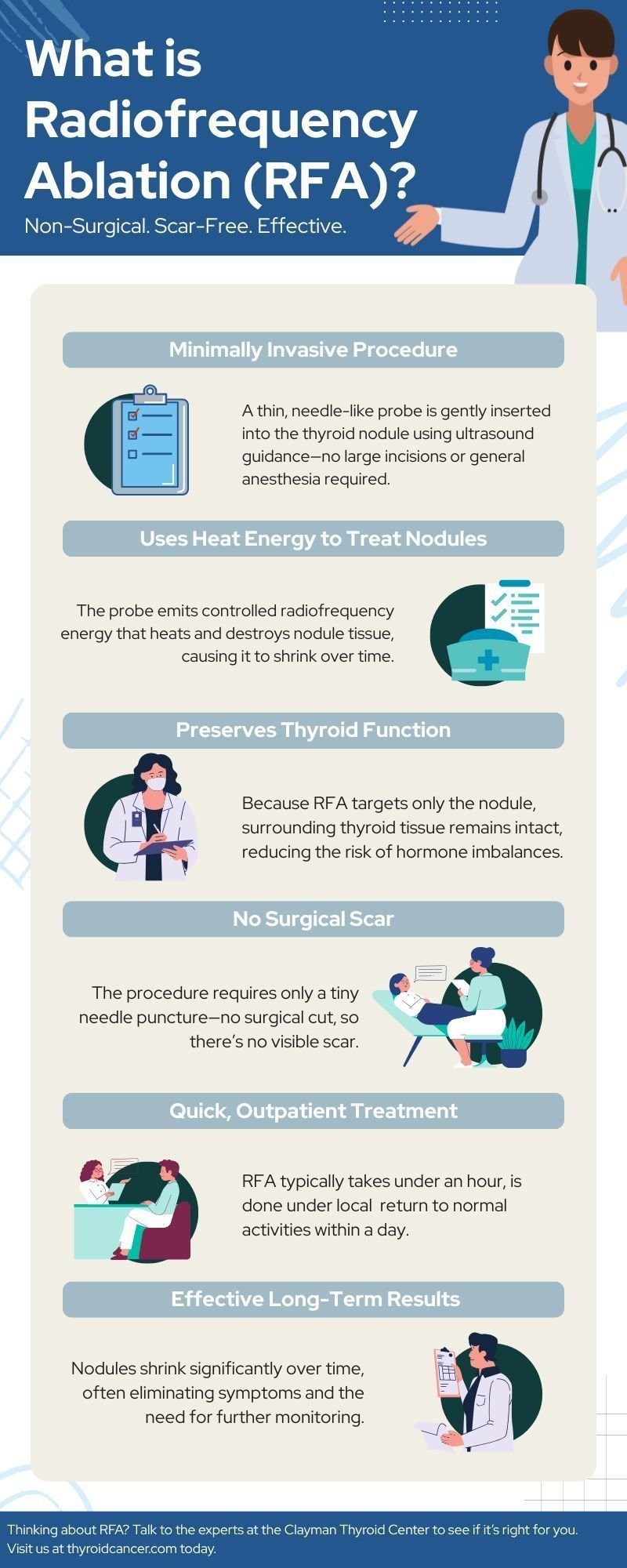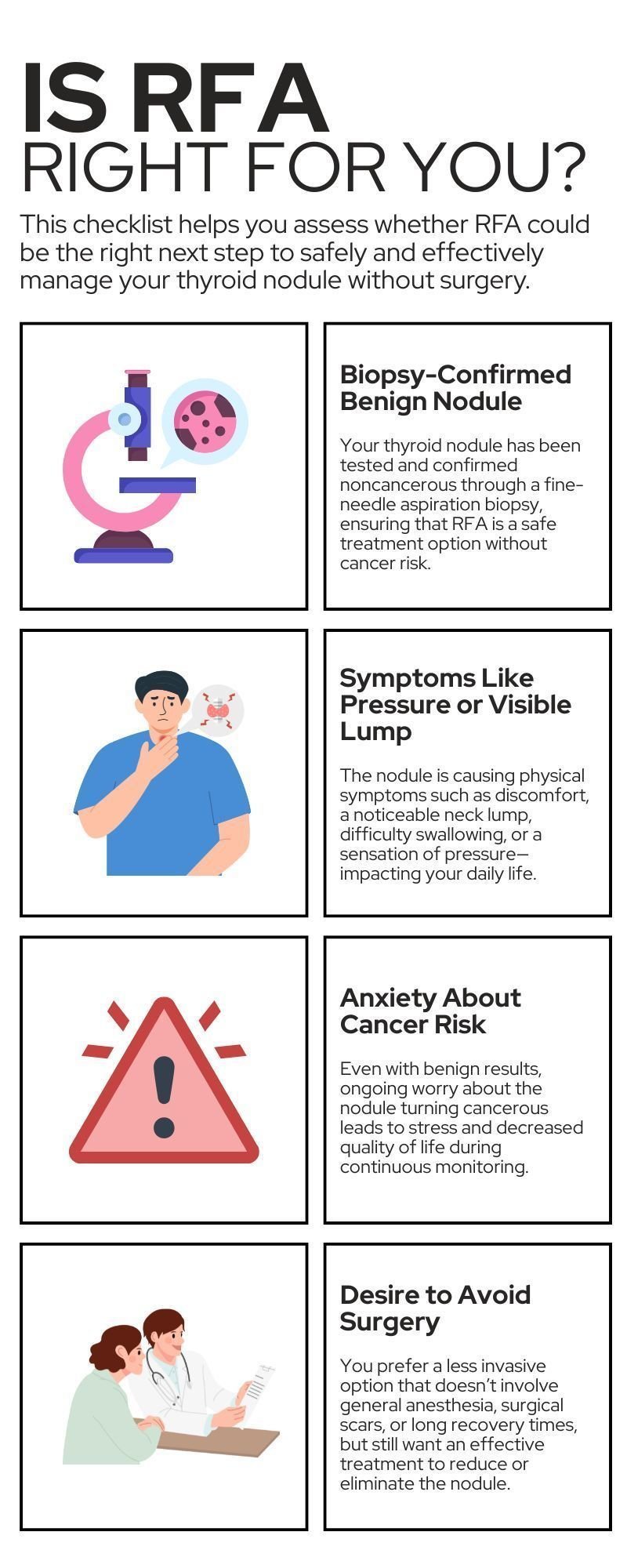Monitoring Thyroid Nodules: Is It Time to Consider RFA Instead?
Monitoring Thyroid Nodules: Is It Time to Consider RFA Instead?
If you've been monitoring thyroid nodules year after year—endless ultrasounds, repeat biopsies, and ongoing worry—you’re not alone. Monitoring thyroid nodules is the standard recommendation for many people with benign, noncancerous nodules. But for some, this “wait and watch” approach brings more anxiety than reassurance. And while surgery might feel like an overreaction, there’s now a middle ground: a minimally invasive option called radiofrequency ablation (RFA).
At the Clayman Thyroid Center, we’re proud to offer RFA as a game-changing solution for patients who are tired of monitoring thyroid nodules that don’t seem to go away, but don’t yet warrant surgery. Here’s what you need to know about monitoring thyroid nodules, and why RFA might be the answer you’ve been waiting for.
What Does Monitoring Thyroid Nodules Mean?
When a thyroid nodule is discovered—usually during a routine neck exam or imaging for another issue—it’s often followed by a thyroid ultrasound to assess its size, shape, and structure. If the nodule appears suspicious, a fine-needle aspiration (FNA) biopsy may be performed to test for cancer.
If the nodule is benign (noncancerous), most doctors recommend monitoring the thyroid nodule over time. This means:
- Repeat ultrasound every 12 months
- Follow-up biopsies if the nodule grows or changes
- Ongoing visits to endocrinologists or thyroid specialists
While this approach is safe, it can also be frustrating, anxiety-provoking, and costly over time. For patients who feel stuck in limbo, monitoring thyroid nodules can start to feel like a lifelong sentence.
Why People Get Tired of Monitoring Thyroid Nodules
Although benign thyroid nodules aren’t dangerous, they can still cause distress. Many patients tell us they’re tired of:
- Frequent ultrasounds and follow-ups
- Needle biopsies that feel invasive or painful
- Fear that the nodule will eventually turn cancerous
- Being told to “just keep an eye on it” year after year
For some, the nodule may slowly enlarge, causing a visible lump in the neck, a sense of pressure, difficulty swallowing, or cosmetic concerns. Still, because it’s benign, traditional surgery often seems like too much.
That’s where RFA comes in.
Monitoring Thyroid Nodules vs. Treating Them With RFA
RFA, or radiofrequency ablation, is a non-surgical, image-guided procedure that uses heat to shrink benign thyroid nodules. It’s ideal for patients who are tired of monitoring thyroid nodules but don’t want to undergo invasive surgery.
RFA is performed under local anesthesia, takes less than an hour, and requires no incision. Most patients return to normal activities the same day.
Key benefits of RFA over monitoring thyroid nodules include:
- Eliminates or reduces the nodule size without surgery
- Stops the need for repeat ultrasounds and biopsies
- Improves cosmetic appearance and compressive symptoms
- Preserves thyroid function and avoids a surgical scar
.jpg)
Who Is a Good Candidate for RFA?
If you’ve been monitoring thyroid nodules and are tired of the uncertainty, you might be a candidate for RFA if:
- You’ve had a biopsy-confirmed benign thyroid nodule
- The nodule is causing symptoms (pressure, visible lump, discomfort)
- You’ve had to monitor the nodule for several years without change
- You’re not interested in surgery or want a minimally invasive option
- You’re anxious about cancer risk despite benign results
Our expert team at the Clayman Thyroid Center evaluates each case thoroughly to determine whether RFA is the right fit. If you’ve been told to keep monitoring your thyroid nodules but want a different path, we can help.
How Does RFA Work?
During RFA, a small needle-like probe is inserted into the thyroid nodule under ultrasound guidance. Using radiofrequency energy, the probe heats and destroys the tissue inside the nodule. Over time, your body naturally shrinks the treated tissue.
This means the nodule reduces in size, symptoms improve, and monitoring may no longer be necessary. Best of all, there’s no general anesthesia, no surgical scar, and no thyroid function loss.
What Is Recovery Like After RFA?
One of the biggest advantages of RFA over monitoring thyroid nodules long-term or undergoing surgery is the recovery process.
After RFA, most patients:
- Go home the same day
- Resume work and normal activities within 24 hours
- Experience minimal discomfort or bruising
- Avoid hospital stays, stitches, or surgical drains
Compared to thyroid surgery—which may require time off work, risk to the vocal cords, or lifelong thyroid hormone replacement—RFA offers a smoother, gentler recovery.
.jpg)
When Monitoring Thyroid Nodules Just Isn’t Enough
For some patients, monitoring thyroid nodules creates more stress than peace of mind. You may start to question:
- Is this going to turn into cancer?
- Will I need another biopsy soon?
- What if I wait too long?
- How much longer will I need to keep monitoring this?
If you’re ready to take action but don’t want surgery, RFA could be the perfect balance—effective treatment with minimal risk.
Why Choose the Clayman Thyroid Center for RFA?
The Clayman Thyroid Center is one of the most experienced thyroid-focused surgical and procedural centers in the world. Our team includes expert endocrine surgeons and specialists trained in the latest technologies, including RFA.
When you come to us, you’re not just another patient on a long ultrasound follow-up schedule. We work with you to understand your goals and help you stop monitoring thyroid nodules endlessly if there’s a safe, effective alternative.
We believe patients should have options—not just “watch and wait” or “go under the knife.” RFA gives you that third option.
Final Thoughts on Monitoring Thyroid Nodules and Considering RFA
If you’re tired of monitoring thyroid nodules and ready for a less invasive, lower-stress solution, RFA might be the right path. It’s safe, and effective, and allows you to move on from the exhausting cycle of ultrasounds, biopsies, and uncertainty.
At the Clayman Thyroid Center, we’re here to help you understand your options and choose the best treatment for your unique case.
To learn more or schedule a consultation, visit ThyroidCancer.com or call our office to speak with a member of our team.
Additional Resources
- Become our patient by filling out the form at this link.
- Learn more about The Clayman Thyroid Center here.
- Learn more about our sister surgeons at the Scarless Thyroid Surgery Center, Norman Parathyroid Center, and Carling Adrenal Center
- Learn more about the Hospital for Endocrine Surgery.